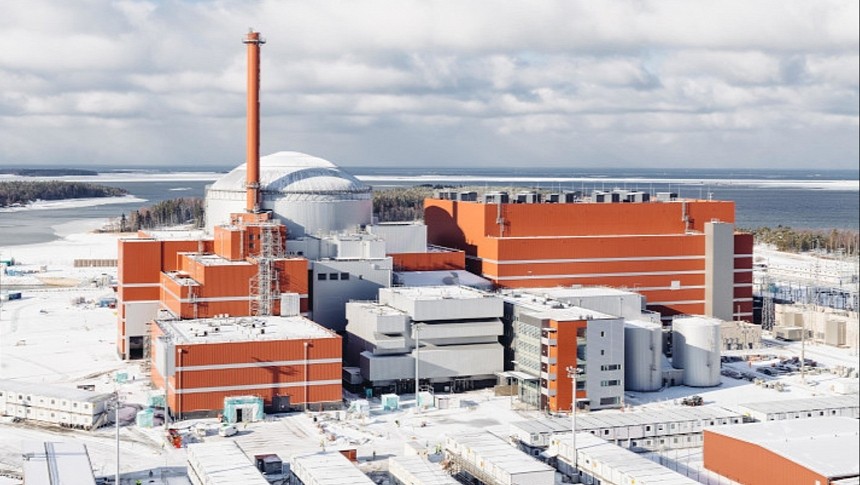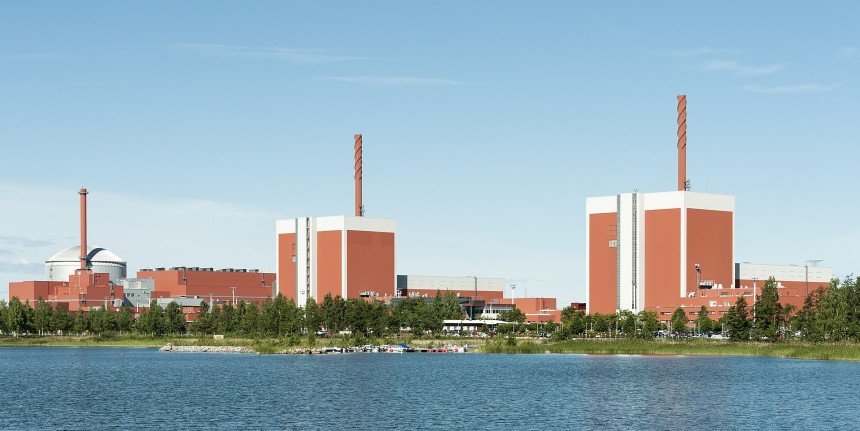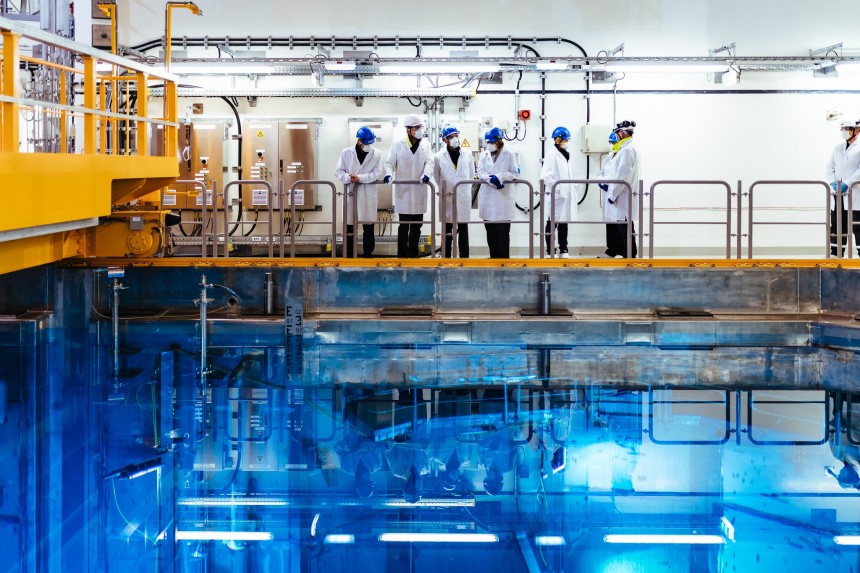Depending on what side of the atomic fence you reside on, the notion of the most powerful reactor in all of Europe going online this month either greatly excites you or terrifies you to your core. In truth, the story of Finland's Olkiluoto Nuclear Power Plant (ONPP) reaches back far beyond when its new third reactor entered commercial service on April 16th, 2023. It's a point of Scandinavian pride that stretches to when Finland was first blossoming on the international stage.
By the early-to-mid 1970s, Finland had borne the brunt of attacks and occupations by both the Soviets and the Germans at different points during World War II, only to keep on trucking. They also operated a free and open market economy despite the Soviet Union being literally right next door while maintaining a relatively neutral stance throughout the escalating Cold War. But what Finland needed most in the latter half of the 20th century was energy. Energy for heating homes, powering businesses, and generally keeping the Finnish state a contemporary economy.
There were a number of routes the Finnish government could have embarked on to make this energy requirement a reality. They could rely on Soviet imports of coal and natural gas, as Finland themselves had little to no domestic coal production at that time, as it still does today. Alternatively, Finland is one of two nations besides Estonia that can still legally burn peat as an energy source. But even 50 years ago, this was seen as a dirty and inefficient way of providing heat. One of the only solutions that made logical sense was to go atomic.
Admittedly, the Olkiluoto Nuclear Power Plant isn't Finland's first nuclear reactor; that honor goes to the Loviisa Nuclear Power Plant, which switched on its first reactor unit in 1971 and the second in 1972. But the nation's second operational reactor plant still needed to supply great swaths of Finland's energy grid with clean, carbon-free electricity. Located on the banks of the Gulf of Bothnia on Olkiluoto Island in the west of Finland, the ONPP's first two reactors would be the toast of Finnish infrastructure by themselves.
These twin reactors, activated in 1974 and 1975, respectively, employ a particularly interesting brand of boiling water reactor (BWR) built by the Swedish ASEA company, now a part of Westinghouse Electric Sweden AB. This type of fission reactor packs a nuclear fissile core consisting of uranium pellets into metal fuel rods in a large reactor vessel. Once this fissile core is lowered into a large cylinder and surrounded by a neutron moderator, usually graphite, to keep the reaction steady, a stream of distilled water is pumped through the reactor core. This creates steam captured through enormous turbines and converted to usable electricity. All the while, nuclear control rods mounted at the top of the vessel can be lowered or raised to alter the rate of reaction as needed.
It's a delightfully simple method of operation, despite how infinitely complicated it can be in practice. Between the two reactor units, Olkiluoto cranked out an impressive 2,500 MW of thermal energy. This translates to roughly 890 MW of usable electricity between the original two reactors. Not an unhealthy sum in the slightest. It's even comparable to the outputs of BWRs from wealthier, more resource-rich Western European and North American countries built around the same time.
Had the ONPP facility remained in this twin-reactor configuration, it still would have been a titan in the Finnish energy sector. But keep this in mind, Finland uses more electricity per capita than any other in Scandinavia and even the rest of the European Union. So in December 2000, the Finnish government applied for a license to begin building a bespoke third reactor complex to be built and installed. In 2005, this project was officially sanctioned, with the Finnish TVO corporation chosen to be the main domestic contractor.
With a radically different design than the first two reactors, the all-important Unit 3 was a top priority of Finnish domestic energy policy. As a part of the project, international collaborators from the Areva NP group, a collaboration between Siemens of Germany and the French Areva company, were brought to Finland to oversee the construction of a single third-generation pressurized water reactor (PWR). Unlike BWRs, pressurized water reactors keep the water pumped through the core under high pressure to prevent it from boiling. When this water reaches a non-pressurized steam chamber, the superheated steam creates a far more ferocious output of thermal energy.
All by itself, ONPP's third reactor unit was due to output a whopping 4,3000 MW of thermal energy and a very impressive 1,600 MW of net useable electricity from a single 526-ton reactor vessel. With construction done by the heavy industries division of Mitsubishi in Japan with help from the century-old Japan Steel Works, this was some of the most capable fission reactor equipment available in the mid-2000s; it's still impressive in the 2020s. But there was a problem lurking beneath the surface.
No sooner was progress on the reactor facility starting to take off than the group tasked with managing the operation started to fall apart. In 2009, Siemens sold off its 33.3 percent stake in the Areva NP group back to Areva, who became the sole foreign overseer of the operation alongside the domestic TVO. Now under the new name Framatome, the company sold off its nuclear reactor operations to the French Électricité de France S.A. All the while, a seemingly endless string of projected completion date overruns plagued the project.
In the end, it was decided to keep Siemens involved in the ONPP's third reactor project as strictly a subcontractor building the facility's turbine hall. All the while, the estimated activation date for reactor number three increased from 2010 to sometime before 2015. By 2020, the estimate was pegged at sometime in February 2022. It'd take until April 2023, 18 years after the project began, to finally get Olkiluoto's prized PWR online and hooked up to the national grid.
Oh, and don't think ONPP will be disposing of its future waste products improperly. Each shipment of spent nuclear fuel from the facility will be inserted into a specially-made disposal canister that's resistant to shock damage and leaks. These canisters will be stored deep underground on-site at the facility where it will be monitored around the clock to make sure no radioactive material makes its way into the surrounding environment.
With the potential to power homes and businesses across all of Southern Finland, including Helsinki, it should be pretty obvious how vital the new and improved Olkiluoto Nuclear Power Plant will be for a country that needs one way or another to heat their homes in the winter. With a menacing Russian bear threatening to freeze all of Europe last winter with nat-gas pipeline shutdowns, it couldn't have come online at a better time.
There were a number of routes the Finnish government could have embarked on to make this energy requirement a reality. They could rely on Soviet imports of coal and natural gas, as Finland themselves had little to no domestic coal production at that time, as it still does today. Alternatively, Finland is one of two nations besides Estonia that can still legally burn peat as an energy source. But even 50 years ago, this was seen as a dirty and inefficient way of providing heat. One of the only solutions that made logical sense was to go atomic.
Admittedly, the Olkiluoto Nuclear Power Plant isn't Finland's first nuclear reactor; that honor goes to the Loviisa Nuclear Power Plant, which switched on its first reactor unit in 1971 and the second in 1972. But the nation's second operational reactor plant still needed to supply great swaths of Finland's energy grid with clean, carbon-free electricity. Located on the banks of the Gulf of Bothnia on Olkiluoto Island in the west of Finland, the ONPP's first two reactors would be the toast of Finnish infrastructure by themselves.
These twin reactors, activated in 1974 and 1975, respectively, employ a particularly interesting brand of boiling water reactor (BWR) built by the Swedish ASEA company, now a part of Westinghouse Electric Sweden AB. This type of fission reactor packs a nuclear fissile core consisting of uranium pellets into metal fuel rods in a large reactor vessel. Once this fissile core is lowered into a large cylinder and surrounded by a neutron moderator, usually graphite, to keep the reaction steady, a stream of distilled water is pumped through the reactor core. This creates steam captured through enormous turbines and converted to usable electricity. All the while, nuclear control rods mounted at the top of the vessel can be lowered or raised to alter the rate of reaction as needed.
Had the ONPP facility remained in this twin-reactor configuration, it still would have been a titan in the Finnish energy sector. But keep this in mind, Finland uses more electricity per capita than any other in Scandinavia and even the rest of the European Union. So in December 2000, the Finnish government applied for a license to begin building a bespoke third reactor complex to be built and installed. In 2005, this project was officially sanctioned, with the Finnish TVO corporation chosen to be the main domestic contractor.
With a radically different design than the first two reactors, the all-important Unit 3 was a top priority of Finnish domestic energy policy. As a part of the project, international collaborators from the Areva NP group, a collaboration between Siemens of Germany and the French Areva company, were brought to Finland to oversee the construction of a single third-generation pressurized water reactor (PWR). Unlike BWRs, pressurized water reactors keep the water pumped through the core under high pressure to prevent it from boiling. When this water reaches a non-pressurized steam chamber, the superheated steam creates a far more ferocious output of thermal energy.
All by itself, ONPP's third reactor unit was due to output a whopping 4,3000 MW of thermal energy and a very impressive 1,600 MW of net useable electricity from a single 526-ton reactor vessel. With construction done by the heavy industries division of Mitsubishi in Japan with help from the century-old Japan Steel Works, this was some of the most capable fission reactor equipment available in the mid-2000s; it's still impressive in the 2020s. But there was a problem lurking beneath the surface.
In the end, it was decided to keep Siemens involved in the ONPP's third reactor project as strictly a subcontractor building the facility's turbine hall. All the while, the estimated activation date for reactor number three increased from 2010 to sometime before 2015. By 2020, the estimate was pegged at sometime in February 2022. It'd take until April 2023, 18 years after the project began, to finally get Olkiluoto's prized PWR online and hooked up to the national grid.
Oh, and don't think ONPP will be disposing of its future waste products improperly. Each shipment of spent nuclear fuel from the facility will be inserted into a specially-made disposal canister that's resistant to shock damage and leaks. These canisters will be stored deep underground on-site at the facility where it will be monitored around the clock to make sure no radioactive material makes its way into the surrounding environment.
With the potential to power homes and businesses across all of Southern Finland, including Helsinki, it should be pretty obvious how vital the new and improved Olkiluoto Nuclear Power Plant will be for a country that needs one way or another to heat their homes in the winter. With a menacing Russian bear threatening to freeze all of Europe last winter with nat-gas pipeline shutdowns, it couldn't have come online at a better time.










